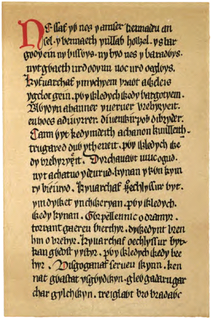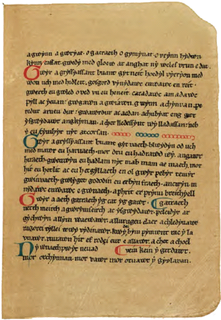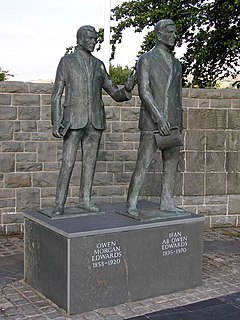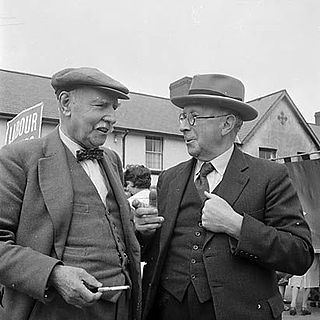
The Mabinogion are the earliest British prose stories, and belong to the Matter of Britain. The stories were compiled in Middle Welsh in the 12th–13th centuries from earlier oral traditions. There are two main source manuscripts, created c. 1350–1410, as well as a few earlier fragments. The title covers a collection of eleven prose stories of widely different types, offering drama, philosophy, romance, tragedy, fantasy and humour, and created by various narrators over time. There is a classic hero quest, "Culhwch and Olwen"; a historic legend in "Lludd and Llefelys," complete with glimpses of a far off age; and other tales portray a very different King Arthur from the later popular versions. The highly sophisticated complexity of the Four Branches of the Mabinogi defies categorisation. The stories are so diverse that it has been argued that they are not even a true collection.

The Red Book of Hergest is a large vellum manuscript written shortly after 1382, which ranks as one of the most important medieval manuscripts written in the Welsh language. It preserves a collection of Welsh prose and poetry, notably the tales of the Mabinogion and Gogynfeirdd poetry. The manuscript derives its name from the colour of its leather binding and from its association with Hergest Court between the late 15th and early 17th century.

The National Library of Wales, Aberystwyth, is the national legal deposit library of Wales and is one of the Welsh Government sponsored bodies. It is the biggest library in Wales, holding over 6.5 million books and periodicals, and the largest collections of archives, portraits, maps and photographic images in Wales. The Library is also home to the national collection of Welsh manuscripts, the National Screen and Sound Archive of Wales, and the most comprehensive collection of paintings and topographical prints in Wales. As the primary research library and archive in Wales and one of the largest research libraries in the United Kingdom, the National Library is a member of Research Libraries UK (RLUK) and the Consortium of European Research Libraries (CERL).
William Ronald Rhys Jones, who used the name Keidrych Rhys, was a Welsh literary journalist and editor, and a poet. He was editor of the periodical, Wales, published from 1937 to 1949 and from 1958 to 1960.

The Black Book of Carmarthen is thought to be the earliest surviving manuscript written solely in Welsh. The book dates from the mid-13th century; its name comes from its association with the Priory of St. John the Evangelist and Teulyddog at Carmarthen, and is referred to as black due to the colour of its binding. It is currently part of the collection of the National Library of Wales, where it is catalogued as NLW Peniarth MS 1.

The Book of Taliesin is one of the most famous of Middle Welsh manuscripts, dating from the first half of the 14th century though many of the fifty-six poems it preserves are taken to originate in the 10th century or before.

The Book of Aneirin is a late 13th century Welsh manuscript containing Old and Middle Welsh poetry attributed to the late 6th century Northern Brythonic poet, Aneirin, who is believed to have lived in present-day Scotland.

Daniel Silvan Evans was a Welsh clergyman, scholar and lexicographer. Educated at the Independent College in Brecon, Silvan Evans worked as a schoolmaster for five years. On marriage he conformed to the Established Church, studying at St David's College, Lampeter, where he became lecturer in Welsh. Ordained deacon in 1848 and priest the following year he served curacies at Llandegwning parish in Llŷn and from 1852 to 1862 at nearby Llangian, Caernarfonshire. In 1862 he was appointed to the living of Llanymawddwy, Merioneth.

Sir Owen Morgan Edwards was a Welsh historian, educationalist and writer. He is often known as O. M. Edwards.
Geiriadur Prifysgol Cymru (GPC) is the only standard historical dictionary of the Welsh language, aspiring to be "comparable in method and scope to the Oxford English Dictionary". Vocabulary is defined in Welsh, and English equivalents are given. Detailed attention is given to variant forms, collocations, and etymology.

The Book of Llandaff, is the chartulary of the cathedral of Llandaff, a 12th-century compilation of documents relating to the history of the diocese of Llandaff in Wales. It is written primarily in Latin but also contains a significant amount of Old and Middle Welsh names and marginalia.
Gwyn Jones was a Welsh novelist and story writer, and a scholar and translator of Nordic literature and history.

Thomas Evan Nicholas, who used the bardic name Niclas y Glais, was a Welsh language poet, preacher, radical, and champion of the disadvantaged of society.
John Ellis Meredith (1904–1981) was a Welsh Presbyterian minister and writer. He was the first Welshman to become president of the National Union of Students.
Brenhinoedd y Saeson is the medieval title of three Middle Welsh annalistic chronicles known from three 14th-century manuscripts recording events from 682 to the English conquest of Wales in 1282. The title Brenhinoedd y Saeson is found only in the rubric to the earlier of the two surviving manuscripts of version S: the other two texts are commonly known as Brut y Tywysogion, but this title is found only in manuscripts of the late 16th century and cannot be considered authentic.
Llafur – the full name of which is Llafur: The Welsh People's History Society – was founded in 1970 as Llafur: The Society for the Study of Welsh Labour History to promote the study of the history of the working people of Wales. Its main activities are the publication of the journal Llafur and a number of individual books. The Society also organises regular day schools and events to engage a wider audience with Welsh People's History.
David James Davies (1893–1956), known as D. J. Davies, was a Welsh economist, industrialist, prize winning essayist, author, political activist, pilot, and an internationalist. Davies was a world traveller before returning home to Wales.
Cambria: A Welsh Geographical Review was a journal published in Wales between 1974 and 1989. Though edited by members of the Geography Departments of Swansea University and Aberystwyth University, the publication was run as an independent business, and production values were basic. Cambria was an annual English-language academic journal containing articles and book reviews on geographical and related topics. It has been digitized by the Welsh Journals Online project at the National Library of Wales.
The Cambrian Law Review is a Welsh academic law journal containing articles on British and international law, book reviews, and obituaries. It is published by the Committee of the Cambrian Law Review, on behalf of the Department of Law and Criminology, Aberystwyth University.
Daniel Huws is the world's leading authority of the last hundred years on Welsh manuscripts, with contributions that are held to represent a significant advance on those of John Gwenogvryn Evans.









